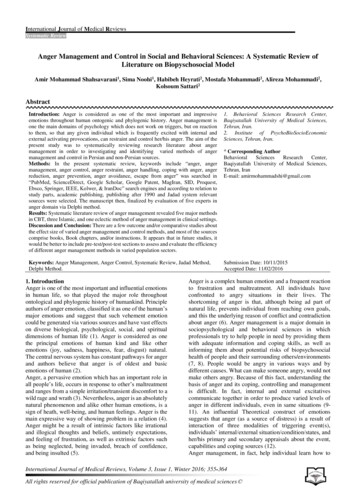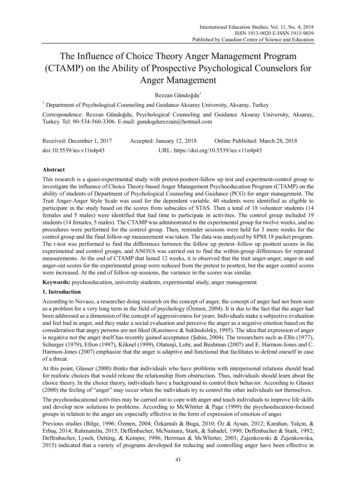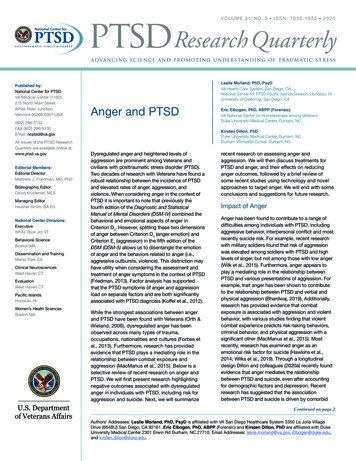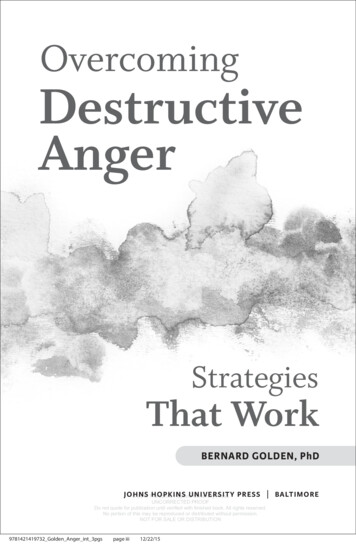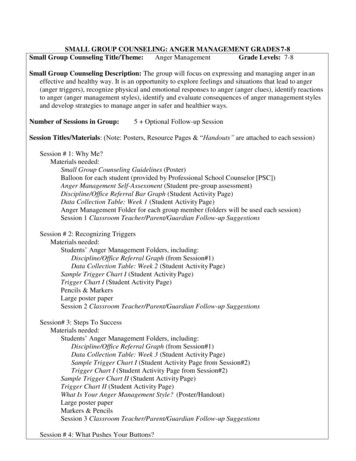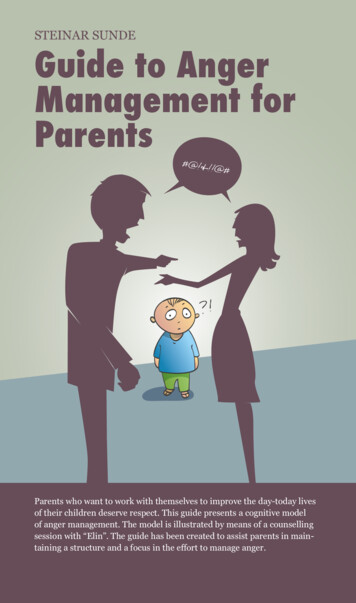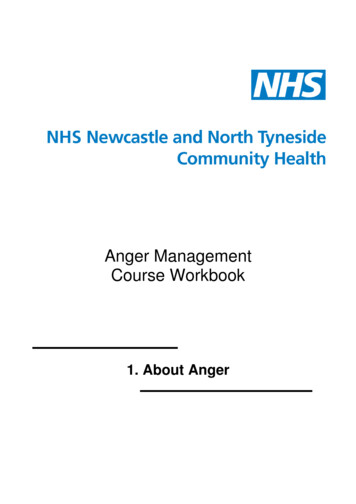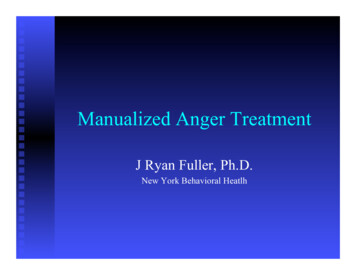
Transcription
Manualized Anger TreatmentJ Ryan Fuller, Ph.D.New York Behavioral Heatlh
Anger is commonn Anger is a basic emotion (Plutchik, 1980)Anger is frequently experienced even bynormative samples (Tafrate, Kassinove, &Dundin, 2002)n Anger is a clinical problem (Lachmund,DiGiuseppe, & Fuller, 2005)n J Ryan Fuller, Ph.D.NewYorkBehavioralHeatlh.com2
What Treatments Work?Cognitive Therapyn Relaxation/Behaviorally Basedn Skills Trainingn Exposure Basedn Combinedn J Ryan Fuller, Ph.D.NewYorkBehavioralHeatlh.com3
Treatment EfficacyMeta-analysis by DiGiuseppe & Tafrate 2003Good Newsn Many treatments influence change in manydifferent types of clients: college students,outpatients, prison inmates, and spouseabusersn Equally effective regardless of age andgenderJ Ryan Fuller, Ph.D.NewYorkBehavioralHeatlh.com4
Treatment Efficacy (2)Good Newsn Change is large (effect sizes for most effective arearound 1.00 for Cohen’s d)n Follow-up studies support maintenanceBad Newsn Most studies use volunteersn These effect sizes are smaller than those found foranxiety and depression treatment- sociallysanctioned, adaptive at times, less JattentionRyan Fuller, Ph.D.NewYorkBehavioralHeatlh.com5
Treatmentn n Manualt Session 1-3Overview and Modelt Session 4-9Skills Acquisitiont Session 10-14Exposure plus Copingt Session 15-16Relapse PreventionGeneralt Organized by componentst Flexible, but skill focusedJ Ryan Fuller, Ph.D.NewYorkBehavioralHeatlh.com6
What are the skills?Assertiveness Trainingn Problem Solvingn Self-monitoringn Response Preventionn Consequential Thinkingn Time Projectionn J Ryan Fuller, Ph.D.NewYorkBehavioralHeatlh.com7
Problem Solving:A Misplaced Fundamentaln Definitionsu Problem: a situation that presentsdifficultyu Problem Solving: a structured strategythat elicits a multitude of responses thatcontains steps to maximize the likelihoodof implementing a viable oneJ Ryan Fuller, Ph.D.NewYorkBehavioralHeatlh.com8
Problem Solving:ExamplesDifficult situation at work with client,vendor, employer, employee2. I am getting into arguments with my spouse3. How to furnish a new room4. My diet plan is not producing the results Iwant5. I can’t find a job or appropriate romanticpartner1.J Ryan Fuller, Ph.D.NewYorkBehavioralHeatlh.com9
Problem Solving:An Empirical ApproachGoldfried and Davison (1976)1. General Orientation2. Define problem3. Generation of Alternatives4. Decision making5. VerificationJ Ryan Fuller, Ph.D.NewYorkBehavioralHeatlh.com10
Problem Solving: Step 11.General Orientationa. Normalize- assume that situation is a normal part of lifeb. Acknowledgement- that it is possible others havecoped with something similarc. Inhibit- halt the tendency to respond with initialimpulseJ Ryan Fuller, Ph.D.NewYorkBehavioralHeatlh.com11
Problem Solving: Step 22.Define problemn a. Operationalize- define all aspects of the issue inconcrete (observable and measurable) waysn b. Dissect- reclassify parts into smaller moremanageable elementsJ Ryan Fuller, Ph.D.NewYorkBehavioralHeatlh.com12
Problem Solving: Step 33.n n n n Generation of Alternativesa. Brainstormingi. Criticism omittedii. Welcome novelty and divergenceiii. Encourage quantity of ideasiv. Improvement and integration ofsuggested ideasJ Ryan Fuller, Ph.D.NewYorkBehavioralHeatlh.com13
Problem Solving: Step 4Decision makingn n n Temporal Consequential Thinking (TCT)i. What is the probability it will achieve thedesired result?ii. If it does work what are the likelyadvantages in the immediate, near, mid,and long-term future?iii. What are the likely disadvantages in theimmediate, near, mid, and long-term future?J Ryan Fuller, Ph.D.NewYorkBehavioralHeatlh.com14
Problem Solving: Step 5Verification & AssessmentTest-Operate-Test-Exit(TOTE; Miller, Galanter & Pribram, 1960)u u Was the implemented plan effective?1.Yes Exit2.No Go back to step 4J Ryan Fuller, Ph.D.NewYorkBehavioralHeatlh.com15
AssertivenessDefinitionn What is it not?u Aggressiveu Passiven Definition #1u Assertiveness: proper expression of anyemotion other than anxiety towardanother person- Joseph Wolpe (1973)n J Ryan Fuller, Ph.D.NewYorkBehavioralHeatlh.com16
Assertiveness: Goalsn Improve interpersonal environmentn Enhance self-efficacyn EmoteJ Ryan Fuller, Ph.D.NewYorkBehavioralHeatlh.com17
AssertivenessTwo Critical Components in definitionn The communication of feelings, desires,wants, and preferencesn The acceptance of another person’s right ofrefusal and recognition he/she may alsoagree but not act congruentlyJ Ryan Fuller, Ph.D.NewYorkBehavioralHeatlh.com18
Assertive CommunicationFour Communication Statementsn n n n When. . . . . . . . . . (Specific Behavior and Context)I feel. . . . . . . .(Specific Emotional State, this is ONEword, not a metaphor or simile)Because. . . . (What I tell myself that causes the emotion,not about him/her)What I would appreciate/like. . . . . . . .(Specific requestof other person)J Ryan Fuller, Ph.D.NewYorkBehavioralHeatlh.com19
Assertive AcceptanceMy Communication Rightsn n I have a right to tell someone what I am feeling.I have a right to ask for what I want.After communicatingn Assertive Acceptance Statementsu Recognition others may not give us what we wantt I recognize that I may not get what I want even when someonesays I will.t Other people have a right to ignore my requests, deny myrequests, promise to grant my request and then not fulfill thecommitment And/Or become emotionally upsetJ Ryan Fuller, Ph.D.NewYorkBehavioralHeatlh.com20
Anger is common ! Anger is a basic emotion (Plutchik, 1980) ! Anger is frequently experienced even by normative samples (Tafrate, Kassinove, & Dundin, 2002) ! Anger is a clinical problem (Lachmund, DiGiuseppe, & Fuller, 2005) J Ryan Fuller, Ph.D. NewYorkBehavioralHeatlh.com 2
